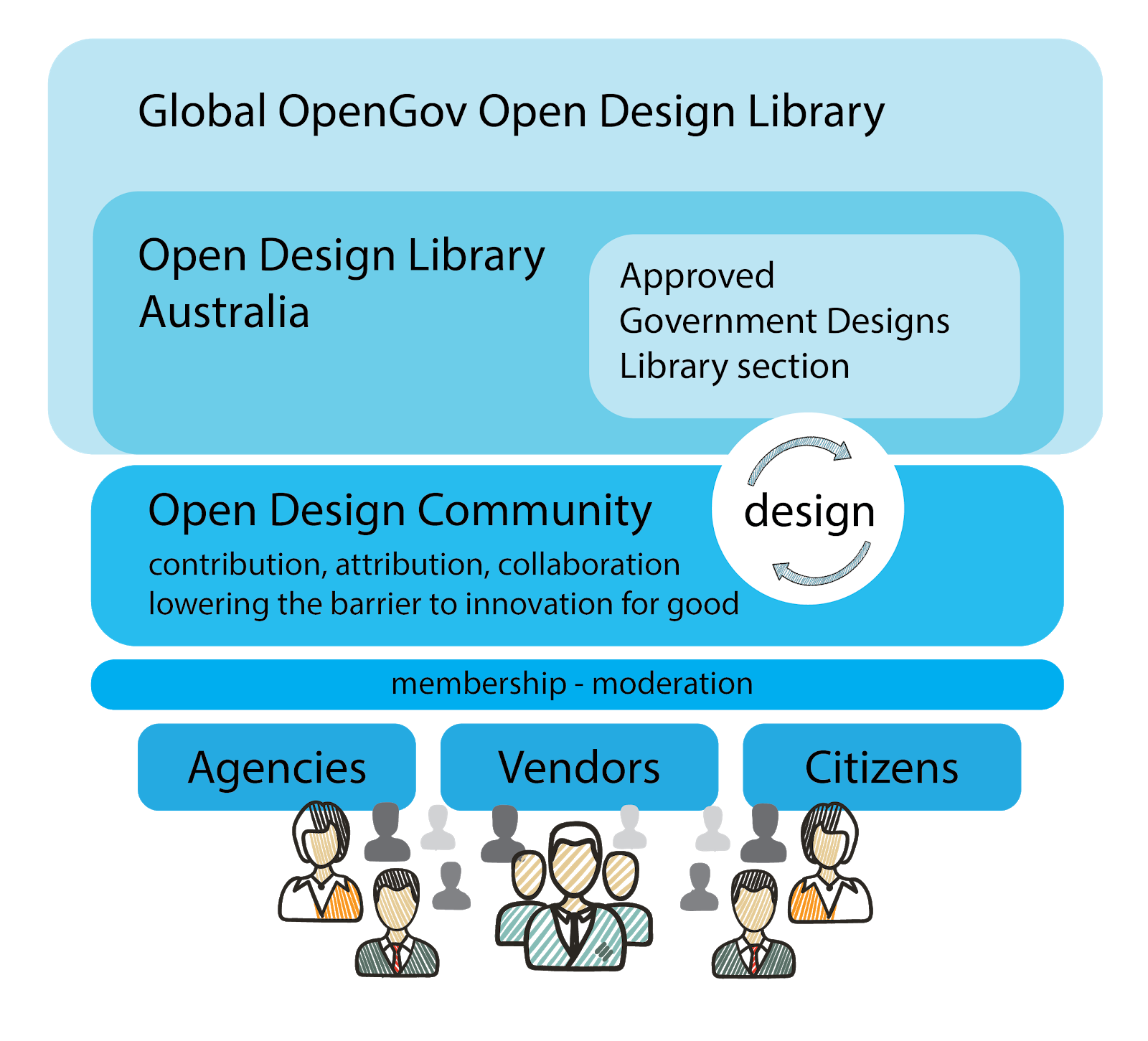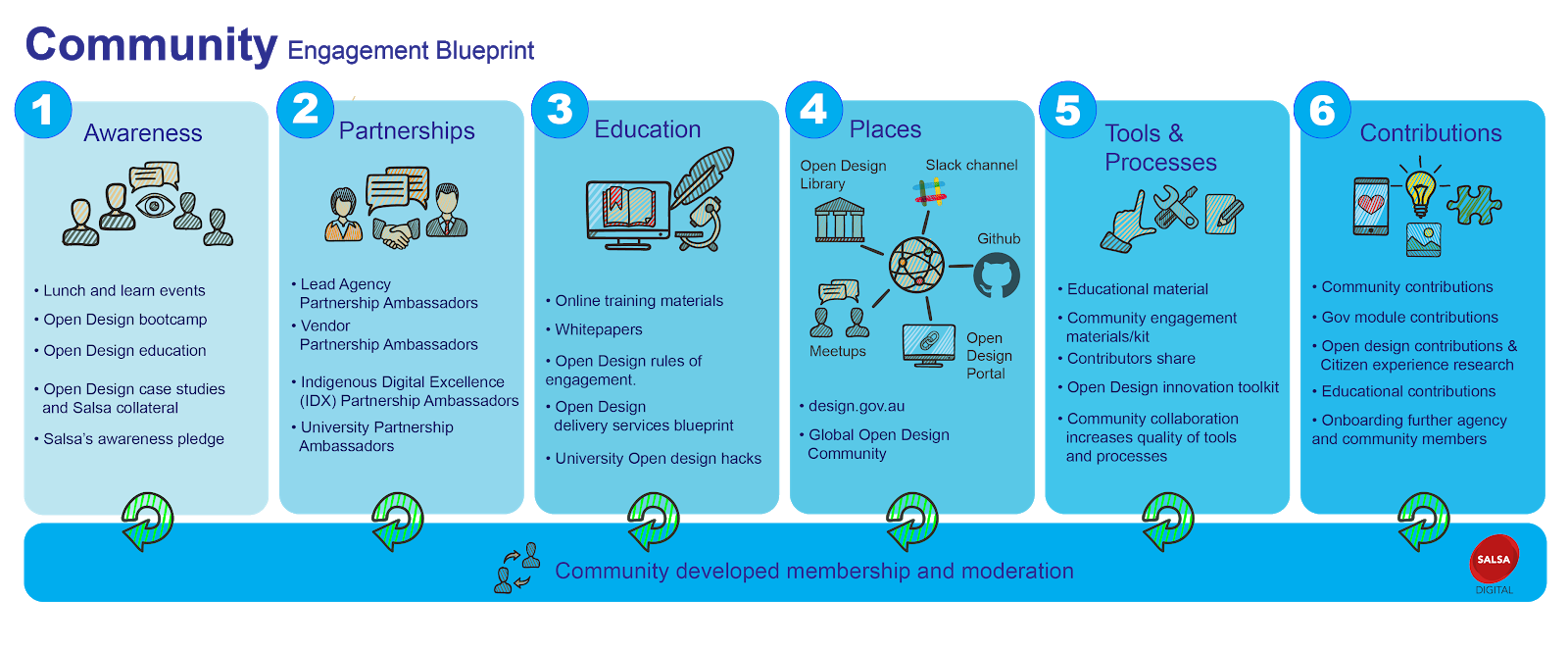
What is open design?
Open design takes the concept of open source technology and open data (both well-known movements) and applies it to digital design artefacts.
Our definition: A design artefact is open if anyone is free to use, reuse and redistribute it. This definition is in line with definitions for other ‘open’ elements and is inspired by . Importantly, this means open design elements are NOT subject to copyright and are NOT owned by one person/organisation/agency.
Why we should embrace open design
There are many natural benefits from creating, co-creating and sharing design elements. These include:
- Save time. Save money.
- Improve shared designs to create better, more citizen-centric designs.
- Give back to the government design community.
- Think global. Sense and apply local.
- Connect communities, experts and promote collaboration.
- Lower the barrier to innovation.
Open design and open government
Open source, open data, open platform and open design can help governments deliver on their open government targets. In fact, we consider these areas to be Salsa Digital’s four pillars for the delivery of open government. Our enthusiasm for open government (and its four pillars) comes down to one thing: lowering the barriers for government and public servants so they can focus on delivering services.
Open design will also help governments become more ‘open’, to deliver on the open government movement. We see open design as a key future driver of the open government movement.
Where we are now
Government agencies are responsible for delivering great digital services and content to citizens. Great digital services involve creating great user experiences. Great user experiences involve understanding users and creating great design.
However, there are two main challenges government agencies currently face:
1. Agencies often create user experiences on separate islands, solving the same type of problems (and patterns) as many other agencies before them…again and again.
2. Repeated effort and thinking translates into unnecessary burn on money and time.
The bottom line: At the moment, government agencies don’t generally share design elements.
Where we want to be
What if an agency could access open and shared design artefacts from a previous agency that solved the same (or similar) problems before them? What if an agency could go even further to improve those design artefacts and then contribute them back?
Salsa has a dream: design.gov.au.
Design.gov.au would be a central place and catalogue to discover, access and contribute public shared and open design artefacts — a library of design elements that can be used and adapted. Our vision is to have it up and running by 2020, hence OpenDesign2020.
Homepage visual concept
Artefacts that could be shared through open design include:
- Citizen research and testing
- Personas
- Information architecture (IA)
- Journey maps
- Wireframes (low fidelity)
- Designs (high fidelity)
- UI design components
- Digital style guides
- Functional prototypes
Open design forms a cycle, where expertise and user research can be fed back into existing designs to improve and update the designs even further, ready for re-use (and even further improvements) by the next government agency. The diagram below represents how the community and key members will work together, and how the open design cycle can create more citizen-centric designs.
Citizen-centric design is a key deliverable for governments today, something that’s being mandated within the open government movement. Open design can deliver on this government policy by sharing citizen research, user research and design artefacts that have been upcycled to deliver the best possible value for the end users — citizens.
Critical success factors
There are several factors critical to the success of OpenDesign2020 (and design.gov.au). They are:
Community engagement: An engaged community that creates value and attains reward.
Contribution: Structural contributions of quality and relevant design artefacts and variations.
Attribution: Creators recognised in all variations of original design work.
Authoritative ownership: Strong leading agency, advocate and ambassador.
Like everything open (open source, open data, etc.) open design is about community, about getting people involved. Our open design blueprint provides a visual of what this might look like, of what it takes to run an open design community program.
Participation in the design.gov.au can be promoted in several different ways, as illustrated in Salsa’s Community Engagement Blueprint below.
For more details on how to drive community engagement, see our full Community Engagement Blueprint.
Features of design-gov.au
These are what we consider the must-have features for design.gov.au:
Digital assets hosting platform: An open source platform that’s secure and resilient, capable of hosting a catalogue of open design artefacts (digital assets) and optionally the physical digital files themselves.
Artefacts schema (metadata) templates: Ability to add and define new, shareable design artefact types, using templates to ensure consistency and easy searchability of assets.
Design artefacts catalogue: Database repository of manageable open design artefacts and all related metadata including source location.
Membership, signup and profile: Ability to support membership, signup and short member profiles.
Contribution and attribution: A database repository of contributors and attributions.
Roles and moderation: The ability to define roles (creator, moderator, contributor, member, etc.) and moderation workflows.
Search, navigation, discoverability and access: Ability to search, navigate and ultimately discover open design artefacts to access (download) and use.
We’ve also identified some should-have features for design.gov.au:
Digital assets manager and repository: database.
Depository and file system of manageable physical digital assets.
And finally, these are the nice-to-have features for design.gov.au:
Dialogue and comments: Ability to support commentary and dialogue around individual open design artefacts.
Rating: Ability for the community to score/rate design artefacts and a series of considered criteria (quality, usefulness, compliance, etc.).
About Salsa Digital
Salsa Digital provides services that ultimately help our clients deliver great digital services, quality content and insightful data to clients and citizens alike.
We’re committed to the open everything movement (OpenX) and to the many benefits this ethos provides including transparency, innovation, and sharing and improving problems and patterns solved by the pioneers before us.
The open source movement has played a key role in the evolution of Salsa. Over the years, as technology and practices have developed, this commitment to open source has grown to encompass a much broader base beyond open source content management systems — open data, open platform and open design. We contribute and deliver services in all these areas, with a strong involvement in specific open source initiatives such as Drupal, Wordpress, GovCMS, Single Digital Presence, Kubernetes/Lagoon and CKAN.
Our strong relationships with government at both the state and federal levels, and our commitment to ‘openness’, have also led to Salsa embracing the open government movement. We are a strong advocate and key contributor to the open government movement.




